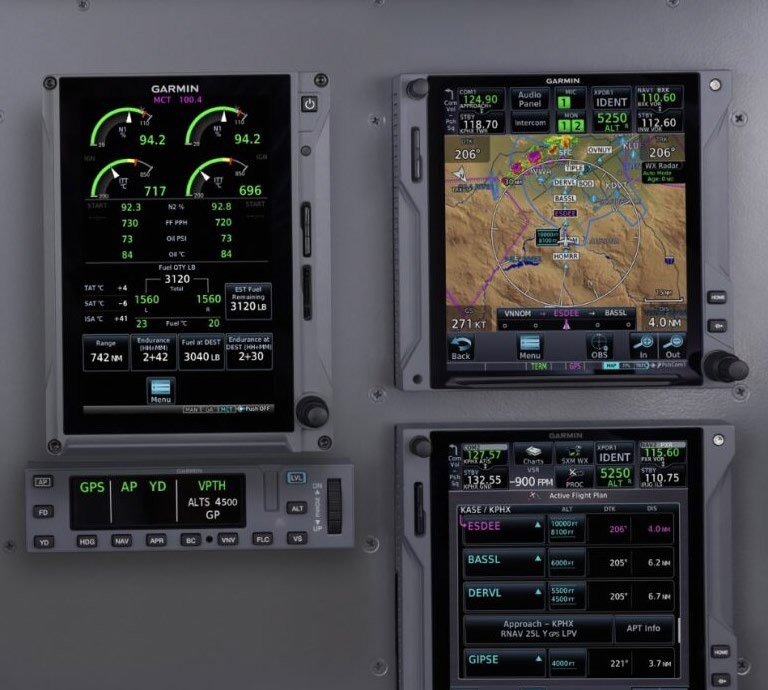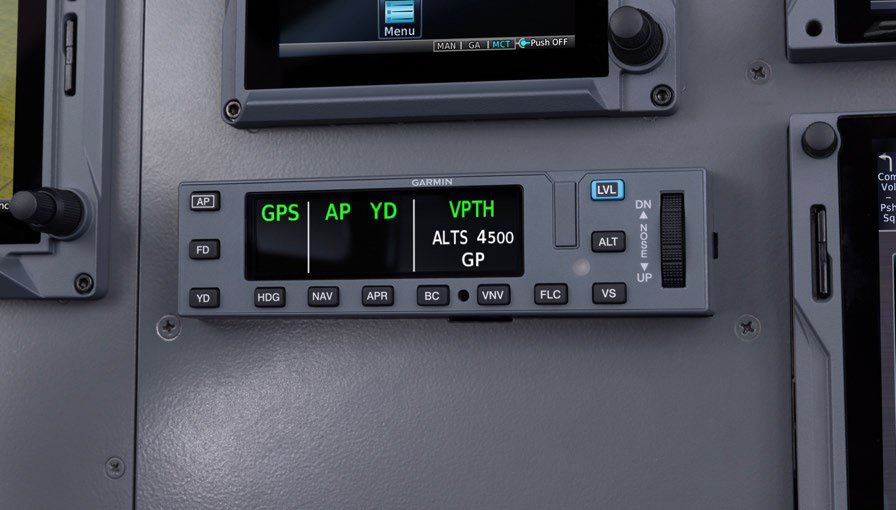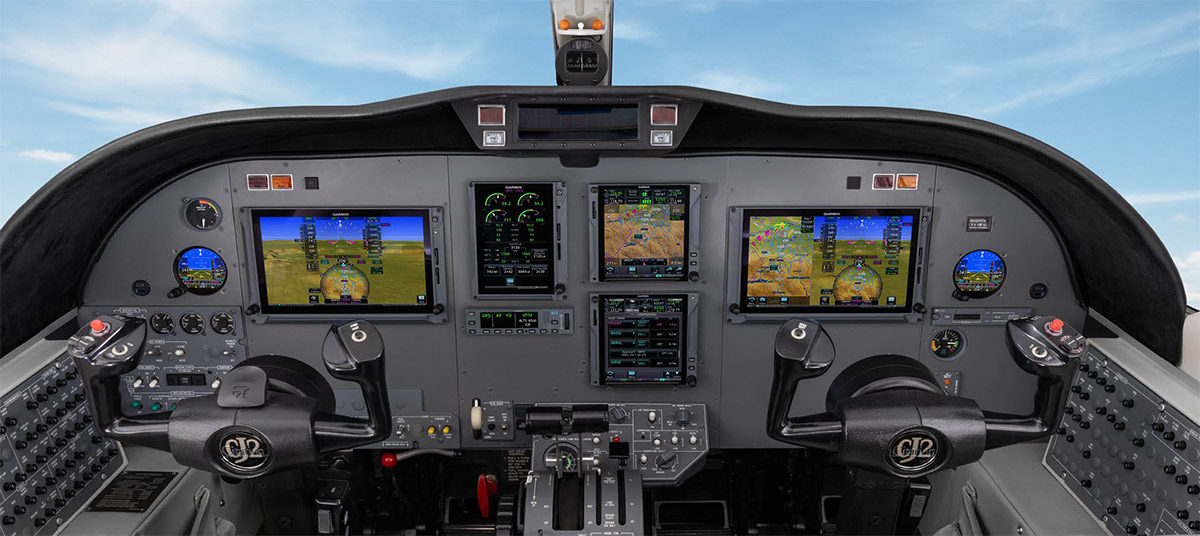All-Garmin Avionics Solution Coming to CJ2
Garmin is pleased to announce upcoming STC approvals for the Cessna Citation CJ2, creating an all-Garmin integrated solution for the popular light jet. As a complete upgrade for the original flight deck, Garmin’s industry-leading avionics solutions will fully replace the legacy systems, modernizing the airplane and reducing pilot workload by bringing new capabilities and safety-enhancing technologies. The all-Garmin retrofit will include TXi™ flight displays, GTN™ Xi navigators, GFC™ 600 digital autopilot and several more optional upgrades.
Flight Displays and Navigation
The all-glass cockpit upgrade features two G600 TXi flight displays providing advanced primary flight display (PFD) and multi-function display (MFD) capabilities with a touchscreen interface. Primary flight data is displayed with a wide horizon view on Garmin synthetic vision technology (SVT™) for optimal awareness in IFR, marginal VFR or nighttime conditions. The PFD also offers a map view within the horizontal situation indicator (HSI) to show weather, traffic, airport diagrams and more without requiring a full MFD window. The CJ2 upgrade includes the GI 275 standby flight instrument on the pilot-side, with an option for an additional instrument on the copilot-side. GI 275 is available with Garmin SVT and seamlessly integrates with the primary flight displays to sync heading, altimeter, airspeed and altitude selections. A notable improvement with the upgrade is the availability of the pilot’s side PFD and each GI 275, while operating on the aircraft’s emergency electrical bus.
The system includes situational awareness features specific to the CJ2, such as Stabilized Approach monitoring and aural V-speed alerting during takeoff. Stabilized Approach monitoring provides an additional layer of protection. While on approach, the system monitors the aircraft to ensure it’s operated in a stabilized manner. Aural annunciations — such as “speed,” “course,” “glidepath” and “sink rate” — notify the pilot if the aircraft is exceeding predetermined speed, course or vertical descent rates.
The TXi Engine Indication System (EIS) will be certified to replace the legacy EIS solution and features a newly refined gauge layout and user interface. EIS-generated or user-selected N1 targets for takeoff, go-around and max continuous thrust settings are integrated and displayed on TXi EIS. N1 reference bugs, which take into account engine and anti-ice status, as well as outside air temperature, are computed automatically and integrated into the TXi EIS display. Pilot-defined N1 reference bugs are also available in the system. Additionally, CJ2 pilots can take advantage of integrated timers on the TXi EIS display, helping pilots respect transient engine limitations during the engine start.

GTN Xi navigators add next-generation GPS/NAV/COMM capabilities to this light jet, enabling coupled descent vertical navigation (VNAV) in combination with the GFC 600 autopilot and allowing pilots to create and execute holding patterns over a published or user-defined waypoint. Pilots can easily visualize the entire flight plan, including departures, arrivals, visual/instrument approaches and more on the navigators 6.9-inch display. For simplified IFR routings, GTN Xi allows pilots to view airway segments available from a waypoint as well as corresponding exit options. Additionally, the flight crew can wirelessly1 load flight plans and share traffic, weather and more from their compatible mobile device.
GFC 600 brings new autopilot capabilities
The GFC 600 digital autopilot delivers CJ2 pilots superior in-flight characteristics and new operational capabilities such as coupled VNAV descents and coupled go-around capability while executing a missed approach, allowing automation to assist during high workload procedures. Guidance from the GTN Xi allows the GFC 600 to seamlessly link the enroute, terminal and approach procedures, allowing continuous descents and smooth VNAV transitions through the instrument approach, simplifying the pilot’s workload in the terminal environment. The CJ2 solution also features Emergency Descent Mode (EDM). In the event of a loss of cabin pressurization, EDM can automatically descend the aircraft to a preset altitude without pilot intervention to help avert hypoxic situations. A color display and flight level change (FLC) mode round out new GFC 600 features on a modernized mode controller for this installation.

GWX 8000 weather radar with Auto Mode
The GWX 8000 StormOptix weather radar simplifies operations and brings peace of mind to single-pilot and crewed aircraft while operating in and near complex weather. Auto Mode lets pilots simply set the range, and the radar automatically adjusts tilt and gain settings to accurately profile weather cells, so pilots can analyze returns from hazardous storm cell activity. The system displays the weather with 16 colors while also showcasing hail and lightning prediction, turbulence detection and advanced ground clutter suppression. The weather radar integrates with TXi flight displays and GTN 750Xi navigators to display radar returns. The new display grouping feature lets pilots operating in the crewed environment look at individual tilts and returns on their side of the cockpit when in manual mode. The GWX 8000 weather radar upgrade is offered as an option, and for more details, visit Garmin.com/GWX8000.
Jet management made easier with PlaneSync
Using a 4G LTE cellular or Wi-Fi® connection provided by the optional GDL® 60 datalink, the PlaneSync connected aircraft management system can help simplify the complexities of owning and operating the CJ2. PlaneSync automatically downloads avionics database updates2 and leverages high-speed integration amongst the avionics to quickly synchronize updates across the displays. The system can operate with a dedicated battery so that operators don’t need to be present and conduct time-consuming manual updates via data card. PlaneSync can also allow pilots to remotely check fuel quantity, database status, GPS location, temperatures and more via the Garmin Pilot™ app3 to help avoid surprises when they arrive at the aircraft. With added capability expected in 2025, PlaneSync can also automatically transmit flight and engine log data to secure cloud storage after landing.
Completing the All-Garmin CJ2 Upgrade Program
CJ2 operators can also take advantage of other optional upgrades to add new capabilities to their aircraft. The GMA™ 35C audio panel adds audio processing with advanced capabilities including auto squelch, 3D audio and Bluetooth® wireless connectivity to allow music or telephone audio from a mobile device. Additionally, the GTX™ 345R transponder can provide ADS-B “Out” capability with optional antenna diversity, while also providing “ADS-B “In” weather and traffic benefits. Other options include the GDL 69A SiriusXM datalink, GTS™ series traffic systems and GSR 56 datalink for weather, calling and messaging connectivity.
The full retrofit solution for the Cessna Citation CJ2 is expected to be available in Q2 of 2024.
1 Optional equipment required. Weather streaming requires compatible ADS-B or SiriusXM
datalink; traffic streaming requirescompatible ADS-B datalink; ADS-B weather available in U.S. only.
2 Active PlaneSync and database subscriptions required for automatic database updates. Active PlaneSync
subscription planrequired for flight log uploading. Features are available on-ground only and requires GDL 60 to have active LTE or
Wi-Fi connectivity; signal strength and other factors may apply. See Garmin.com/PlaneSyncCoverage for LTE coverage
details.
3 Remote aircraft status requires active PlaneSync subscription.
User’s smart device must have internet connectivity. Feature isavailable on-ground only and requires GDL 60 to have LTE
connectivity; signal strength and other factors may apply. SeeGarmin.com/PlaneSyncCoverage for coverage details.
one year ago


